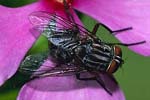 Description: 1/8-1/4" (3-6 mm). Gray with 4 black lengthwise stripes on thorax. Abdomen gray or yellowish with dark midline and irregular dark markings on sides. Eyes reddish. Antennal bristle (arista) slightly feathery. Mouthparts expanded at end, suitable for sponging up food. Legs hairy; each tarsus has adhesive pads and sharp claws. Wings clear, held level and straight back.
Description: 1/8-1/4" (3-6 mm). Gray with 4 black lengthwise stripes on thorax. Abdomen gray or yellowish with dark midline and irregular dark markings on sides. Eyes reddish. Antennal bristle (arista) slightly feathery. Mouthparts expanded at end, suitable for sponging up food. Legs hairy; each tarsus has adhesive pads and sharp claws. Wings clear, held level and straight back.
- Food Adult sucks liquids containing sweet or decaying substances. Larva feeds on moist food rich in organic matter.
- Life Cycle Female lays 5-6 batches of 75-120 oval, white eggs on moist manure or garbage. Eggs hatch in 10-24 hours. Larvae reach full size in 5 days emerging as adults about 5 days later. Males live for 15 days, females up to 26 if they have access to milk, sugar, and water.
- Habitat Near horse manure, garbage, or exposed food.
- Range Worldwide, except in Antarctica and a few remote islands.
- Discussion 98 percent or more of the flies caught in houses are House Flies. Because they can transmit typhoid fever, cholera, dysentery, pinworms, hookworms, and some tapeworms, House Flies are regarded as a greater threat to human health than most other insects. The larger and darker Face Fly (M. autumnalis), 1/4-3/8" (6-8 mm), resembles the House Fly but settles on cow rather than horse manure. It creeps into the nostrils and eyes of cattle and into horse fly wounds.